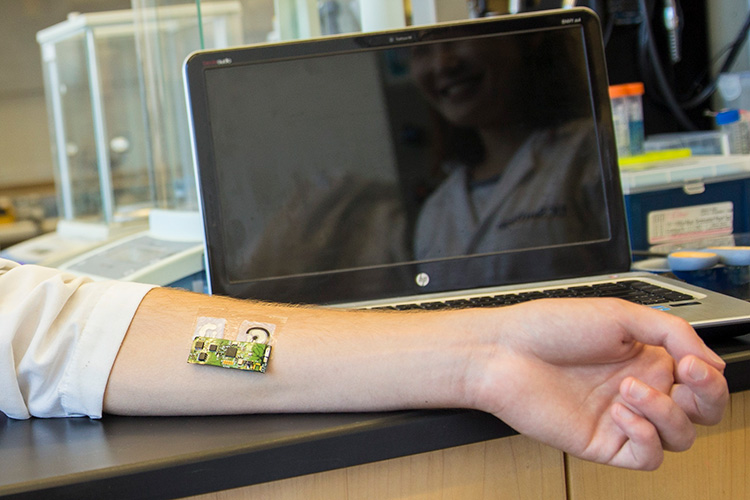Daily Business Report-Sept. 15, 2017
Flexible wearable sensor for detecting alcohol level can be worn on the arm. (Courtesy of UC San Diego Jacobs School of Engineering)
Flexible Wearable Electronic Skin Patch
Offers New Way to Monitor Alcohol Levels
By Liezel Labios | UC San Diego News Center
Engineers at the University of California San Diego have developed a flexible wearable sensor that can accurately measure a person’s blood alcohol level from sweat and transmit the data wirelessly to a laptop, smartphone or other mobile device. The device can be worn on the skin and could be used by doctors and police officers for continuous, non-invasive and real-time monitoring of blood alcohol content.
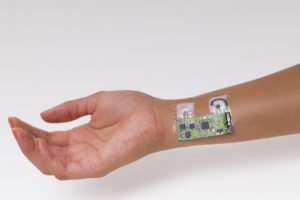
The device consists of a temporary tattoo — which sticks to the skin, induces sweat and electrochemically detects the alcohol level — and a portable flexible electronic circuit board, which is connected to the tattoo by a magnet and can communicate the information to a mobile device via Bluetooth. The work, led by nanoengineering professor Joseph Wang and electrical engineering professor Patrick Mercier, both at UC San Diego, was published recently in the journal ACS Sensors.
“Lots of accidents on the road are caused by drunk driving. This technology provides an accurate, convenient and quick way to monitor alcohol consumption to help prevent people from driving while intoxicated,” Wang said. The device could be integrated with a car’s alcohol ignition interlocks, or friends could use it to check up on each other before handing over the car keys, he added.
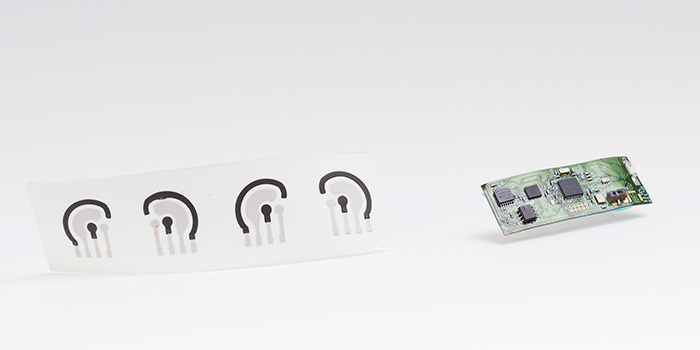
“When you’re out at a party or at a bar, this sensor could send alerts to your phone to let you know how much you’ve been drinking,” said Jayoung Kim, a materials science and engineering PhD student in Wang’s group and one of the paper’s co-first authors.
Blood alcohol concentration is the most accurate indicator of a person’s alcohol level, but measuring it requires pricking a finger. Breathalyzers, which are the most commonly used devices to indirectly estimate blood alcohol concentration, are non-invasive, but they can give false readouts. For example, the alcohol level detected in a person’s breath right after taking a drink would typically appear higher than that person’s actual blood alcohol concentration. A person could also fool a breathalyzer into detecting a lower alcohol level by using mouthwash.
Recent research has shown that blood alcohol concentration can also be estimated by measuring alcohol levels in what’s called insensible sweat—perspiration that happens before it’s perceived as moisture on the skin. But this measurement can be up to two hours behind the actual blood alcohol reading. On the other hand, the alcohol level in sensible sweat—the sweat that’s typically seen—is a better real-time indicator of the blood alcohol concentration, but so far the systems that can measure this are neither portable nor fit for wearing on the body.
Now, UC San Diego researchers have developed an alcohol sensor that’s wearable, portable and could accurately monitor alcohol level in sweat within 15 minutes.
“What’s also innovative about this technology is that the wearer doesn’t need to be exercising or sweating already. The user can put on the patch and within a few minutes get a reading that’s well correlated to his or her blood alcohol concentration. Such a device hasn’t been available until now,” Mercier said.
How It Works
Wang and Mercier, the director and co-director, respectively, of the UC San Diego Center for Wearable Sensors, collaborated to develop the device. Wang’s group fabricated the tattoo, equipped with screen-printed electrodes and a small hydrogel patch containing pilocarpine, a drug that passes through the skin and induces sweat.
Mercier’s group developed the printed flexible electronic circuit board that powers the tattoo and can communicate wirelessly with a mobile device. His team also developed the magnetic connector that attaches the electronic circuit board to the tattoo, as well as the device’s phone app.
“This device can use a Bluetooth connection, which is something a breathalyzer can’t do. We’ve found a way to make the electronics portable and wireless, which are important for practical, real-life use,” said Somayeh Imani, an electrical engineering PhD student in Mercier’s lab and a co-first author on the paper.
The tattoo works first by releasing pilocarpine to induce sweat. Then, the sweat comes into contact with an electrode coated with alcohol oxidase, an enzyme that selectively reacts with alcohol to generate hydrogen peroxide, which is electrochemically detected. That information is sent to the electronic circuit board as electrical signals. The data are communicated wirelessly to a mobile device.
Putting the Tattoo to the Test
Researchers tested the alcohol sensor on 9 healthy volunteers who wore the tattoo on their arms before and after consuming an alcoholic beverage (either a bottle of beer or glass of red wine). The readouts accurately reflected the wearers’ blood alcohol concentrations.
The device also gave accurate readouts even after repeated bending and shaking. This shows that the sensor won’t be affected by the wearer’s movements, researchers said.
As a next step, the team is developing a device that could continuously monitor alcohol levels for 24 hours.
Click here to access this story on the UC San Diego News Center site
___________________

33 Companies Selected as Finalists for
30th Annual Most Innovative New Product Awards
CONNECT has announced 33 finalist for the 30th annual Most Innovative New Product Awards.
The awards ceremony is a CONNECT signature event, held annually, that honors San Diego’s stars of innovation along with their newly launched groundbreaking products. As part of the 30th anniversary celebration CONNECT will present the 2017 Hall of Fame Award to Jay Flatley, executive chairman of Illumina, the Duane Roth Distinguished Contribution Awards for Life Science and Technology, and the CONNECT Founders’ Award.
“We’re thrilled to be celebrating our 30th year of celebrating the life-altering products and services that are being created in San Diego,” said Greg McKee, president and CEO of CONNECT. “These companies are raising the bar of our flourishing innovation economy and continuing to grow San Diego’s presence on the international stage as a hub of successful life science and tech companies.”
There were nearly 100 submissions into this year’s Most Innovative New Product Awards.
Click here for the list of all finalists.
___________________
Credit Union Wants Naming Rights
for former Qualcomm Stadium
The San Diego City Council will vote Tuesday on a proposal to rename the city’s stadium in Mission Valley after the San Diego County Credit Union, which would pay $500,000 for the naming rights through Dec. 31, 2018.
The new proposed name would be SDCCU Stadium.
Under the city’s Stadium Sponsorship Sales Agreement with Fox Sports, the city would retain 75 percent of the revenue, which equals $375,000.
“We are excited SDCCU has been announced as the preferred naming rights partner for the City Council’s upcoming vote on stadium naming rights,” said Teresa Halleck, SDCCU president and CEO. “This new partnership illustrates SDCCU’s ongoing support of the greater San Diego community.”
First named San Diego Stadium when it opened in 1967, the facility was officially renamed San Diego Jack Murphy Stadium in 1981 in honor of the late San Diego Union sportswriter who was instrumental in helping bring the Chargers football team to San Diego. In 1997, after a major renovation and expansion of the stadium, a 20-year deal was made with Qualcomm for naming rights. That deal expired this year.
___________________
Cal State San Marcos Honored
for Excellence in Diversity
California State University San Marcos has received the 2017 Higher Education Excellence in Diversity award from INSIGHT Into Diversity magazine, the oldest and largest diversity-focused publication in higher education. This is the fourth straight year that CSUSM has been named an award recipient.
The national honor recognizes U.S. colleges and universities that demonstrate an outstanding commitment to diversity and inclusion. CSUSM will be featured along with 79 other recipients in INSIGHT Into Diversity magazine’s November 2017 issue.
CSUSM was selected based on the institution’s exemplary diversity and inclusion initiatives, and ability to support a broad definition of diversity on campus, including gender, race, ethnicity, veterans, people with disabilities, members of the LGBTQ community, as well as all others.
___________________
USD to Dedicate Garden to Kumeyaay Nation
The University of San Diego has announced the dedication of a garden to honor the history and contributions of the Kumeyaay Nation. On Friday, Sept. 22, USD, in conjunction with the Office of Tribal Liaison, will dedicate the garden and public art piece located north of the University Center bordering the south ridge of Tecolote Canyon as the Kumeyaay Garden. The dedication is from 3 to 5 p.m.
In celebrating Native American culture, the event will include bird songs, storytelling, ethnobotany tours, Kumeyaay cultural activities, and an art exhibition. Hands-on activities include basket making, Kumeyaay games, and smoothies made with ingredients gathered from plants indigenous to Southern California.
___________________
Salk Discovery Offers Insights into Mental Illness
Salk Institute scientists have discovered that an interaction between two key proteins helps regulate and maintain the cells that produce neurons. The work, published in Cell Stem Cell on Thursday, offers insight into why an imbalance between these precursor cells and neurons might contribute to mental illness or age-related brain disease. Read more…
___________________
Scripps Hospital Exceeds All Others
in County for Key Heart Surgery
Scripps Memorial Hospital La Jolla was the only hospital in San Diego County rated above average for outcomes in coronary artery bypass graft surgery (CABG) with a valve replacement or repair, according to a report released by the Office of Statewide Health Planning and Development. All hospitals within the state that perform CABG surgeries are required to submit data to the state. Read more…
___________________
New Nano Implant Could
One Day Help Restore Sight
A team of engineers at the University of California San Diego and La Jolla-based startup Nanovision Biosciences Inc. has developed the nanotechnology and wireless electronics for a new type of retinal prosthesis that brings research a step closer to restoring the ability of neurons in the retina to respond to light. The researchers demonstrated this response to light in a rat retina interfacing with a prototype of the device in vitro.
___________________
Northrop Grumman Awarded $57.7M
Navy Contract for Troop Protection
The Navy has awarded Northrop Grumman Corp. a $57.7 million contract to produce a system that provides personnel protection from improvised explosive devices (IEDs). The system would protect troops on foot, in vehicles and in structures. The formal name of the system is the Joint Counter Radio-Controlled Improvised Explosive Device Electronic Warfare (JCREW).
The contract, awarded by the U.S. Naval Sea Systems Command, includes options which if exercised would bring the total value to $505 million. Northrop Grumman will produce the systems in San Diego and complete the work by August 2022.
___________________
Cubic Corp. to Demo Systems
at Space & Cyber Conference
GovCon Executive
Cubic Corp. will exhibit a range of virtual and air combat training platforms at the three-day Air, Space & Cyber Conference that will kick off on Sept. 18 in National Harbor, Md. The company said its mission solutions and global defense businesses will demonstrate several training tools such as Air Combat Maneuvering Instrumentation training platforms, Social Media Analytic Replication Toolkit and Synthetic ISR. The business units will also showcase at the Air Force Association-hosted event command, control, communications, computers, intelligence, surveillance and reconnaissance systems such as Cross Domain, cloud-based Unified Video and satellite communications antenna platforms.
Mike Twyman, president of Cubic Mission Solutions, said the event would provide the company an opportunity to demonstrate C4ISR platforms designed to facilitate integration and support clients’ future missions.
The conference provides product demonstrations, keynote presentations and networking opportunities for government and industry participants
___________________
Personnel Announcements
Nick Lovgren Joins Dersch Design & Engineering
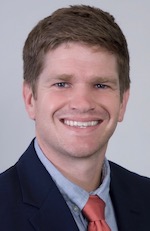
Nick Lovgren has joined Dersch Design & Engineering as an electical engineer. In his new position, Lovgren designs electrical systems for commercial customers, government agencies and utilities.
Prior to joining Dersch Design, Lovgren held the position of electrical engineer at CRB Consulting Engineers in Carlsbad. He worked on an interdisciplinary team with architects, mechanical engineers, plumbing designers and process engineers on a wide array of new construction and tenant improvement projects.
Lovgren also served as LEED administrator when projects sought LEED certification. He co-led CRB’s Sustainable Design Expert Team and was a major contributor to CRB’s Revit library.
Lovgren attended California Polytechnic State University at San Luis Obispo where he received both his Bachelor of Science and Master of Science in Electrical Engineering with a dual emphasis in power systems and power electronics.
___________________
Scripps Health Promotes Shiraz Fagan and Richard Neale

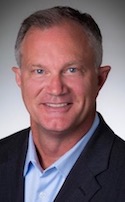
Scripps Health has promoted Shiraz Fagan to the role of chief operating officer and Richard Neale to the role of chief growth officer, two new senior executive team positions created to enhance the organization’s focus on cost management and strategic growth. Fagan and Neale will assume their new roles on Oct. 1.
Fagan is currently chief executive of the Scripps Medical Foundation, where she manages the daily operations of Scripps Clinic, Scripps Coastal Medical Center and the Scripps Cardiovascular and Thoracic Surgery Group. After joining Scripps in 2002 as a senior project manager in Scripps’ Project Management Office, she served as chief operating executive for Scripps Clinic and as vice president of physician services before assuming her current position in 2012, where she has been instrumental to the integration of ambulatory and hospital services at Scripps. As chief operating officer of Scripps Health, Fagan will continue to focus on greater integration and cost containment.
Neale is currently corporate senior vice president of corporate development, overseeing collaborations and partnerships, geographic expansion and innovative business opportunities. Since joining Scripps in 2008, he has held several executive roles in which he led a realignment of Clinical Research Services and helped to significantly grow ambulatory business through Scripps affiliated independent physicians.

